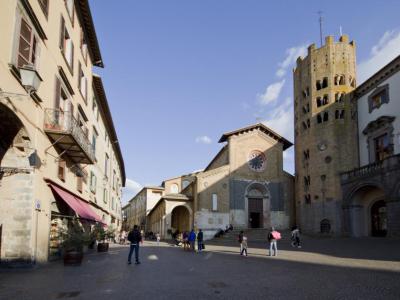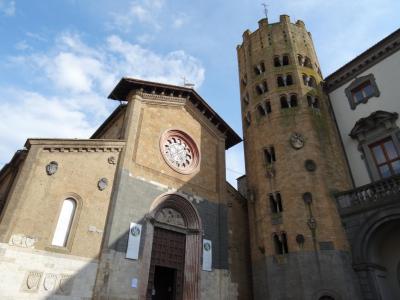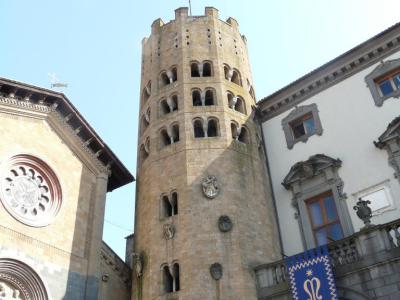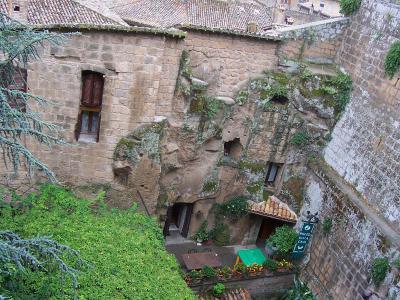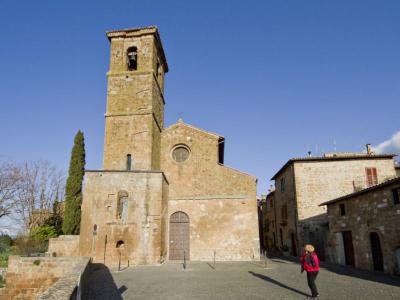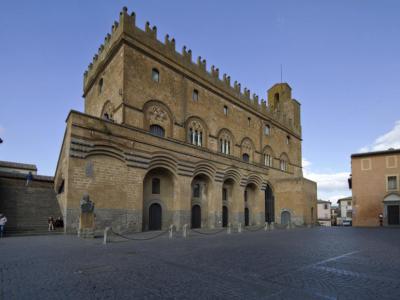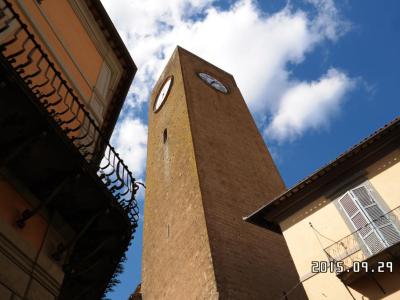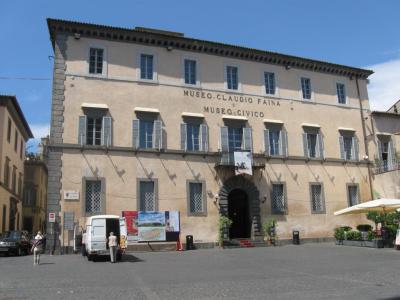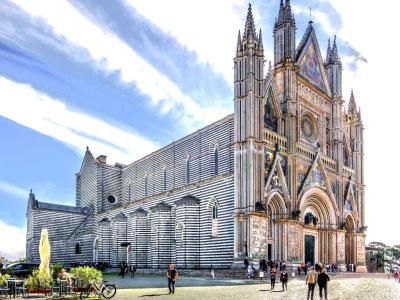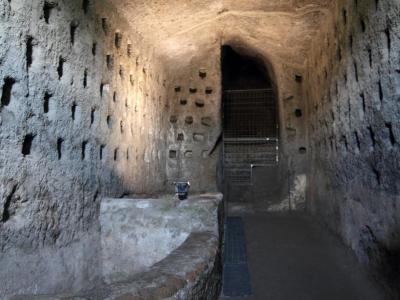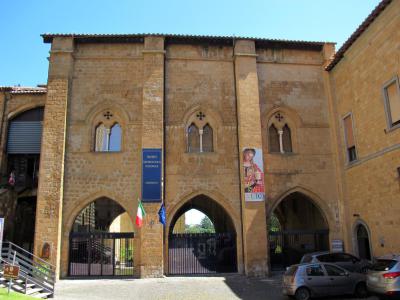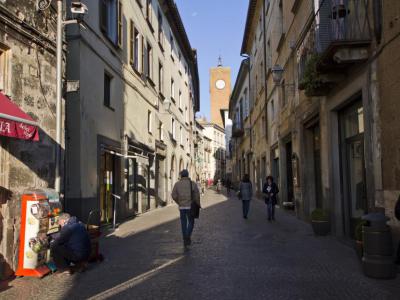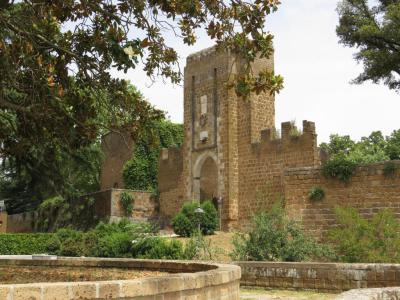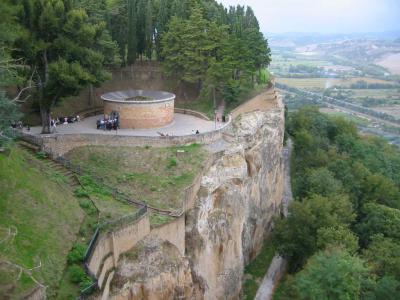Orvieto Introduction Walking Tour (Self Guided), Orvieto
Some 100 kilometers north of Rome, in the picturesque region of Umbria, lies the old town of Orvieto overlooking the Paglia valley from atop a volcanic plateau. The name "Orvieto" stems from “urbs vetus” which means “ancient town” in Latin. Indeed, Orvieto is old, with its roots traced to Etruscan times, circa the 9th century BC.
Despite having been a major center of Etruscan civilization, as evidenced by artifacts housed in the National Archaeological Museum of Orvieto, the city truly flourished during the Roman era. Thanks to its strategic location on a steep crag of soft limestone called tufa, Orvieto was annexed by Rome in the 3rd century BC.
In the 10th century AD, Orvieto established a self-governing commune. Throughout the 13th century, its significance continued to grow and the city governed itself through a podestà, often the bishop, and a military governor, called the "captain of the people."
Orvieto also flourished as a cultural center. It hosted a small university (“studium”), granted by Pope Gregory IX in 1236, which eventually evolved into the Pontifical University of Saint Thomas Aquinas, named so after Thomas Aquinas who taught there.
Controlled by the papacy for centuries, Orvieto officially became part of the Papal States before finally joining unified Italy in 1860.
There are two distinct towns in Orvieto, the upper old town and a newer one in the valley. The former contains most of Orvieto's tourist attractions. Some of the most interesting of them lie underground, such as the Quarry Well Archaeological Complex (Pozzo della Cava) and Orvieto Underground.
Orvieto's main street, Corso Cavour, traverses the town from east to west. At its junction with Via del Duomo is the Torre del Moro, an iconic clock tower commanding attention from various vantage points.
At its western end is the busy Republic Square (Piazza della Repubblica), with several outstanding buildings. Beside the massive 12th-century Palazzo Comunale is the unusual tower of Saints Andrea and Bartolomeo church (Chiesa di Santi Andrea e Bartolomeo).
The awe-inspiring Orvieto Cathedral (Duomo di Orvieto), is a Gothic masterpiece that cannot be missed. Also, make sure to descend into the depths of Saint Patrick's Well (Pozzo di San Patrizio), an architectural marvel that testifies to the ingenuity of Renaissance engineering.
For those with an insatiable curiosity, Orvieto is a captivating destination that offers a deep dive into the annals of Italian heritage. Come and discover the allure of this ancient gem in the heart of Umbria. Your adventure awaits!
Despite having been a major center of Etruscan civilization, as evidenced by artifacts housed in the National Archaeological Museum of Orvieto, the city truly flourished during the Roman era. Thanks to its strategic location on a steep crag of soft limestone called tufa, Orvieto was annexed by Rome in the 3rd century BC.
In the 10th century AD, Orvieto established a self-governing commune. Throughout the 13th century, its significance continued to grow and the city governed itself through a podestà, often the bishop, and a military governor, called the "captain of the people."
Orvieto also flourished as a cultural center. It hosted a small university (“studium”), granted by Pope Gregory IX in 1236, which eventually evolved into the Pontifical University of Saint Thomas Aquinas, named so after Thomas Aquinas who taught there.
Controlled by the papacy for centuries, Orvieto officially became part of the Papal States before finally joining unified Italy in 1860.
There are two distinct towns in Orvieto, the upper old town and a newer one in the valley. The former contains most of Orvieto's tourist attractions. Some of the most interesting of them lie underground, such as the Quarry Well Archaeological Complex (Pozzo della Cava) and Orvieto Underground.
Orvieto's main street, Corso Cavour, traverses the town from east to west. At its junction with Via del Duomo is the Torre del Moro, an iconic clock tower commanding attention from various vantage points.
At its western end is the busy Republic Square (Piazza della Repubblica), with several outstanding buildings. Beside the massive 12th-century Palazzo Comunale is the unusual tower of Saints Andrea and Bartolomeo church (Chiesa di Santi Andrea e Bartolomeo).
The awe-inspiring Orvieto Cathedral (Duomo di Orvieto), is a Gothic masterpiece that cannot be missed. Also, make sure to descend into the depths of Saint Patrick's Well (Pozzo di San Patrizio), an architectural marvel that testifies to the ingenuity of Renaissance engineering.
For those with an insatiable curiosity, Orvieto is a captivating destination that offers a deep dive into the annals of Italian heritage. Come and discover the allure of this ancient gem in the heart of Umbria. Your adventure awaits!
How it works: Download the app "GPSmyCity: Walks in 1K+ Cities" from Apple App Store or Google Play Store to your mobile phone or tablet. The app turns your mobile device into a personal tour guide and its built-in GPS navigation functions guide you from one tour stop to next. The app works offline, so no data plan is needed when traveling abroad.
Orvieto Introduction Walking Tour Map
Guide Name: Orvieto Introduction Walking Tour
Guide Location: Italy » Orvieto (See other walking tours in Orvieto)
Guide Type: Self-guided Walking Tour (Sightseeing)
# of Attractions: 14
Tour Duration: 2 Hour(s)
Travel Distance: 3.4 Km or 2.1 Miles
Author: DanaOffice
Sight(s) Featured in This Guide:
Guide Location: Italy » Orvieto (See other walking tours in Orvieto)
Guide Type: Self-guided Walking Tour (Sightseeing)
# of Attractions: 14
Tour Duration: 2 Hour(s)
Travel Distance: 3.4 Km or 2.1 Miles
Author: DanaOffice
Sight(s) Featured in This Guide:
- Piazza della Repubblica (Republic Square)
- Chiesa di Santi Andrea e Bartolomeo (Church of Saints Andrea and Bartolomeo)
- Torre Dodecagonale (Dodecagonal Tower)
- Pozzo della Cava (Quarry Well Archaeological Complex)
- San Giovenale Church
- Palace of the Captain of the People
- Torre del Moro (Moro Tower)
- Museo Claudio Faina (Claudio Faina Museum)
- Duomo di Orvieto (Orvieto Cathedral)
- Orvieto Underground
- National Archaeological Museum of Orvieto
- Corso Cavour (Cavour Street)
- Fortezza Albornoz (Albornoz Fortress)
- Pozzo di San Patrizio (St. Patrick's Well)
1) Piazza della Repubblica (Republic Square)
The Republic Square traces its roots back to the Etruscan era when it served as the core of the ancient city. The square is adorned with a mix of architectural gems, showcasing a harmonious blend of historical styles. Notable landmarks include Palazzo Comunale (the City Hall), Palazzo Vescovile (the Bishop's Palace), and the charming Sant'Andrea Church. This religious edifice carries historical significance as it was the location where Pope Innocent proclaimed the commencement of one of the Crusades.
The square frequently hosts a bustling farmer's market, where stalls brim with local produce and goods, offering a glimpse into daily life in Orvieto. Visitors can also relish the culinary delights offered by the numerous small restaurants and cafes surrounding the square.
As night falls, the round tower in the square is beautifully illuminated, casting a magical glow over the surroundings. The enchanting play of light enhances the square's charm and invites evening strolls.
The square is encircled by an array of shops, eateries, and establishments, making it an excellent place for shopping or enjoying a leisurely meal. Visitors can explore the local boutiques and artisanal stores.
Republic Square serves as a vibrant social gathering place, attracting both locals and tourists. It provides an ideal spot to pause, relax, and observe the lively atmosphere while savoring a gelato or a traditional Italian espresso.
While it provides a scenic and vibrant setting, the square is also a practical transportation hub. Travelers may encounter motorbikes, scooters, and the occasional small public bus passing through, adding to the lively urban atmosphere.
The square frequently hosts a bustling farmer's market, where stalls brim with local produce and goods, offering a glimpse into daily life in Orvieto. Visitors can also relish the culinary delights offered by the numerous small restaurants and cafes surrounding the square.
As night falls, the round tower in the square is beautifully illuminated, casting a magical glow over the surroundings. The enchanting play of light enhances the square's charm and invites evening strolls.
The square is encircled by an array of shops, eateries, and establishments, making it an excellent place for shopping or enjoying a leisurely meal. Visitors can explore the local boutiques and artisanal stores.
Republic Square serves as a vibrant social gathering place, attracting both locals and tourists. It provides an ideal spot to pause, relax, and observe the lively atmosphere while savoring a gelato or a traditional Italian espresso.
While it provides a scenic and vibrant setting, the square is also a practical transportation hub. Travelers may encounter motorbikes, scooters, and the occasional small public bus passing through, adding to the lively urban atmosphere.
2) Chiesa di Santi Andrea e Bartolomeo (Church of Saints Andrea and Bartolomeo)
The Church of Saints Andrea e Bartolomeo is renowned for its beautiful facade, impressive interior, and its role in the religious life of the community. The church's origins date back to the 11th century when it was built in the Romanesque style. Over the centuries, it underwent several renovations and restorations, resulting in the blend of architectural styles that can be observed today.
The church's facade is one of its most striking features. It is adorned with intricate sculptural decorations, including detailed reliefs and figures. The facade showcases a harmonious mix of Romanesque and Gothic elements, making it a captivating sight for visitors.
Upon entering the church, visitors are greeted by a serene and elegant interior. The nave features a cruciform layout with a central dome, a common architectural feature in many Italian churches. The interior is decorated with frescoes and art from various periods, offering a glimpse into the church's rich history and artistic heritage.
The Church of Saints Andrea e Bartolomeo houses several important religious artworks. Among them is the altarpiece depicting the Madonna and Child with Saints Andrew and Bartholomew, a work attributed to the renowned Renaissance artist Luca Signorelli.
The church's facade is one of its most striking features. It is adorned with intricate sculptural decorations, including detailed reliefs and figures. The facade showcases a harmonious mix of Romanesque and Gothic elements, making it a captivating sight for visitors.
Upon entering the church, visitors are greeted by a serene and elegant interior. The nave features a cruciform layout with a central dome, a common architectural feature in many Italian churches. The interior is decorated with frescoes and art from various periods, offering a glimpse into the church's rich history and artistic heritage.
The Church of Saints Andrea e Bartolomeo houses several important religious artworks. Among them is the altarpiece depicting the Madonna and Child with Saints Andrew and Bartholomew, a work attributed to the renowned Renaissance artist Luca Signorelli.
3) Torre Dodecagonale (Dodecagonal Tower)
The Dodecagonal Tower, is a unique and distinctive architectural gem. As its name suggests, the most striking feature of the Dodecagonal Tower is its unusual geometric shape. Unlike most traditional square or round towers, this tower boasts twelve sides, which gives it a truly distinctive appearance. It is one of the few dodecagonal towers in Italy.
The tower has a rich history that dates back to the medieval period. It was likely constructed in the 13th or 14th century and served various purposes over the centuries, including as a watchtower, defensive structure, or even a place for the city's nobility.
The tower's exterior is adorned with architectural details that reflect the medieval craftsmanship of its time. Visitors can appreciate the intricacies of the stonework, windows, and other decorative elements.
The tower has a rich history that dates back to the medieval period. It was likely constructed in the 13th or 14th century and served various purposes over the centuries, including as a watchtower, defensive structure, or even a place for the city's nobility.
The tower's exterior is adorned with architectural details that reflect the medieval craftsmanship of its time. Visitors can appreciate the intricacies of the stonework, windows, and other decorative elements.
4) Pozzo della Cava (Quarry Well Archaeological Complex) (must see)
The Quarry Well is entirely excavated from the rock on which Orvieto is built and consists of two interconnected sections, reaching a depth of 36 meters. These two sections include a small rectangular Etruscan well and a round Renaissance well designed for spring water.
The history of Quarry Well is closely tied to Pope Clement VII, who sought refuge in Orvieto in 1527 during the Sack of Rome. Concerned about the city's water supply in case of a siege, the Pope ordered the excavation and adaptation of this well to reach the spring water. Additionally, Pope Clement VII commissioned the construction of the famous St. Patrick's Well on the opposite side of the town.
The rediscovery of Quarry Well came in December 1984 when Tersilio Sciarra uncovered the well after more than three centuries of disuse. At that time, the well was only 25 meters deep, filled with earth and debris. The restoration work began in the spring of 1996, aiming to return the structure to its original appearance.
In addition to the well itself, visitors to Quarry Well can explore nine caves surrounding it. These caves offer insights into medieval life, including the use of small pits known as "butti" for disposing of rubbish. The caves also reveal remnants of ancient Etruscan burial tombs and medieval foundations, such as a large pillar that supported the medieval Filippeschi tower.
One of the most impressive underground chambers measures 14 meters and served as a tuff quarry in the 18th and 19th centuries. Within this chamber, you'll find an Etruscan tunnel, a second Etruscan well, and various medieval and Renaissance artifacts. Notably, there are two kilns for pottery: a large medieval kiln from a ceramic workshop featuring majolica and terracotta artifacts, and a smaller kiln used for firing precious Renaissance "lusterware" pottery.
The underground spaces also include rooms excavated during the Middle Ages for the production and storage of Orvieto's renowned wines. These rooms feature staircases and repurposed Etruscan cisterns that collected rainwater from nearby rooftops.
During the Christmas season, the Quarry Well hosts a special event called "The Christmas Crib in the Well," featuring self-moving life-size characters and creating a new experience each year.
The history of Quarry Well is closely tied to Pope Clement VII, who sought refuge in Orvieto in 1527 during the Sack of Rome. Concerned about the city's water supply in case of a siege, the Pope ordered the excavation and adaptation of this well to reach the spring water. Additionally, Pope Clement VII commissioned the construction of the famous St. Patrick's Well on the opposite side of the town.
The rediscovery of Quarry Well came in December 1984 when Tersilio Sciarra uncovered the well after more than three centuries of disuse. At that time, the well was only 25 meters deep, filled with earth and debris. The restoration work began in the spring of 1996, aiming to return the structure to its original appearance.
In addition to the well itself, visitors to Quarry Well can explore nine caves surrounding it. These caves offer insights into medieval life, including the use of small pits known as "butti" for disposing of rubbish. The caves also reveal remnants of ancient Etruscan burial tombs and medieval foundations, such as a large pillar that supported the medieval Filippeschi tower.
One of the most impressive underground chambers measures 14 meters and served as a tuff quarry in the 18th and 19th centuries. Within this chamber, you'll find an Etruscan tunnel, a second Etruscan well, and various medieval and Renaissance artifacts. Notably, there are two kilns for pottery: a large medieval kiln from a ceramic workshop featuring majolica and terracotta artifacts, and a smaller kiln used for firing precious Renaissance "lusterware" pottery.
The underground spaces also include rooms excavated during the Middle Ages for the production and storage of Orvieto's renowned wines. These rooms feature staircases and repurposed Etruscan cisterns that collected rainwater from nearby rooftops.
During the Christmas season, the Quarry Well hosts a special event called "The Christmas Crib in the Well," featuring self-moving life-size characters and creating a new experience each year.
5) San Giovenale Church
San Giovenale Church is believed to have been built on the site of an ancient Etruscan temple dedicated to Jupiter. The church's origins trace back to an early Christian structure, likely from the 6th century, which was also dedicated to San Giovenale and stood alongside another religious building dedicated to San Savino.
The present-day church was constructed in 1004 with the support of local affluent families and was officially documented as a parish church in 1028. The Romanesque style characterizes its initial architectural design, with a tall bell tower positioned beside the austere facade. Remnants of the Romanesque porch and blind arches from that period can still be seen, while an inscription on the lateral door reveals it was constructed in 1497. The upper part of the church was rebuilt in 1825, preserving the original lower section.
Inside, the church boasts an array of 12th and 13th-century paintings, including votive frescoes created by the Orvieto school. These frescoes were recently uncovered after being concealed during the Baroque renovations of 1632. One of the most prominent works is the 15th-century Maestà, known as the Madonna del Soccorso, generously donated by the Ghezzi family in the 16th century. The marble altar, a remarkable example of Byzantine sculpture, bears the date 1170 and is flanked by late 13th-century marble lecterns featuring symbols of the Evangelists.
The baptistry within the church houses a 14th-century fresco depicting the Ascension of Christ. The entrance is adorned with 9th-century carved pavement slabs, and the 15th-century font adds to the church's historical and artistic significance.
The present-day church was constructed in 1004 with the support of local affluent families and was officially documented as a parish church in 1028. The Romanesque style characterizes its initial architectural design, with a tall bell tower positioned beside the austere facade. Remnants of the Romanesque porch and blind arches from that period can still be seen, while an inscription on the lateral door reveals it was constructed in 1497. The upper part of the church was rebuilt in 1825, preserving the original lower section.
Inside, the church boasts an array of 12th and 13th-century paintings, including votive frescoes created by the Orvieto school. These frescoes were recently uncovered after being concealed during the Baroque renovations of 1632. One of the most prominent works is the 15th-century Maestà, known as the Madonna del Soccorso, generously donated by the Ghezzi family in the 16th century. The marble altar, a remarkable example of Byzantine sculpture, bears the date 1170 and is flanked by late 13th-century marble lecterns featuring symbols of the Evangelists.
The baptistry within the church houses a 14th-century fresco depicting the Ascension of Christ. The entrance is adorned with 9th-century carved pavement slabs, and the 15th-century font adds to the church's historical and artistic significance.
6) Palace of the Captain of the People
Palace of the Captain of the People is a historic palace with a rich history dating back to the end of the 13th century. It was originally constructed to serve as the institutional seat of the Capitano del Popolo, a prominent figure during that era in Italy and various other municipalities. The Capitano del Popolo held a significant representative role, representing the interests of the common people.
The Palace of the Captain of the People features a striking architectural design, including a loggia with porticoes. One of its most magnificent spaces is the Sala dei Quattrocento, a room of great historical and artistic significance. Below ground, the palace houses an extraordinary archaeological treasure: the Etruscan foundations adorned with the engraved letter "A" on the stone blocks, providing a tangible link to the region's ancient past.
The Palace of the Captain of the People is currently closed to the public for regular tours. It now functions as a conference venue, so general visitors are not permitted to enter. However, the impressive exterior can still be viewed and appreciated from Peoples' Plaza, even though access to the interior is restricted.
Each year, the historical Corpus Domini procession in Orvieto commences from this location, further highlighting the enduring historical and cultural significance of Palace of the Captain of the People within the community.
The Palace of the Captain of the People features a striking architectural design, including a loggia with porticoes. One of its most magnificent spaces is the Sala dei Quattrocento, a room of great historical and artistic significance. Below ground, the palace houses an extraordinary archaeological treasure: the Etruscan foundations adorned with the engraved letter "A" on the stone blocks, providing a tangible link to the region's ancient past.
The Palace of the Captain of the People is currently closed to the public for regular tours. It now functions as a conference venue, so general visitors are not permitted to enter. However, the impressive exterior can still be viewed and appreciated from Peoples' Plaza, even though access to the interior is restricted.
Each year, the historical Corpus Domini procession in Orvieto commences from this location, further highlighting the enduring historical and cultural significance of Palace of the Captain of the People within the community.
7) Torre del Moro (Moro Tower)
The Moro Tower dates back to the 13th century, during the medieval period when Orvieto was a thriving city-state. It was originally built as a watchtower and a means of defense for the town. The tower's name, "Torre del Moro," is thought to be derived from the Moorish-style battlements that adorn its crown.
Standing at approximately 47 meters (154 feet) tall, the Torre del Moro dominates Orvieto's skyline. The tower is constructed primarily of local stone and features traditional medieval architecture. Its sturdy walls and stone masonry reflect the defensive purpose it served in Orvieto's history. The decorative crenellations at the top add to its picturesque appearance.
At the top of the tower, visitors will encounter a clock mechanism that was added in the 19th century. The clock, with its mechanical workings, is an intriguing piece of historical technology. Additionally, the tower houses a large bell that still chimes to mark the hours.
The main attraction of the Torre del Moro is undoubtedly the stunning panoramic views it offers. Visitors can climb to the top of the tower for panoramic views of the town, the rolling hills of Umbria, and even as far as the distant Apennine Mountains. The climb to the top involves ascending a spiral staircase with more than 200 steps, making it a rewarding yet physically challenging experience.
Standing at approximately 47 meters (154 feet) tall, the Torre del Moro dominates Orvieto's skyline. The tower is constructed primarily of local stone and features traditional medieval architecture. Its sturdy walls and stone masonry reflect the defensive purpose it served in Orvieto's history. The decorative crenellations at the top add to its picturesque appearance.
At the top of the tower, visitors will encounter a clock mechanism that was added in the 19th century. The clock, with its mechanical workings, is an intriguing piece of historical technology. Additionally, the tower houses a large bell that still chimes to mark the hours.
The main attraction of the Torre del Moro is undoubtedly the stunning panoramic views it offers. Visitors can climb to the top of the tower for panoramic views of the town, the rolling hills of Umbria, and even as far as the distant Apennine Mountains. The climb to the top involves ascending a spiral staircase with more than 200 steps, making it a rewarding yet physically challenging experience.
8) Museo Claudio Faina (Claudio Faina Museum)
The Claudio Faina Museum houses an extensive and diverse collection of Etruscan artifacts, including pottery, ceramics, sculptures, jewelry, and funerary objects. These items offer valuable insights into the daily life, artistry, and religious practices of the Etruscan people.
Orvieto and its surroundings are steeped in Etruscan history, and the museum's collection reflects this heritage. Visitors can explore the origins, development, and decline of the Etruscan civilization through the exhibits.
Some of the most remarkable displays in the museum are the replicas of Etruscan tombs. These reproductions allow visitors to step into the world of the Etruscans and gain a better understanding of their burial customs and beliefs. The museum plays a crucial role in preserving and showcasing the Etruscan heritage of Orvieto and the broader region.
Museo Claudio Faina offers an educational and immersive experience for visitors interested in archaeology and ancient history. The displays are accompanied by informative descriptions and explanations, making it an excellent resource for learning about the Etruscans.
Orvieto and its surroundings are steeped in Etruscan history, and the museum's collection reflects this heritage. Visitors can explore the origins, development, and decline of the Etruscan civilization through the exhibits.
Some of the most remarkable displays in the museum are the replicas of Etruscan tombs. These reproductions allow visitors to step into the world of the Etruscans and gain a better understanding of their burial customs and beliefs. The museum plays a crucial role in preserving and showcasing the Etruscan heritage of Orvieto and the broader region.
Museo Claudio Faina offers an educational and immersive experience for visitors interested in archaeology and ancient history. The displays are accompanied by informative descriptions and explanations, making it an excellent resource for learning about the Etruscans.
9) Duomo di Orvieto (Orvieto Cathedral) (must see)
The Duomo di Orvieto is a true masterpiece of Gothic architecture, renowned for its stunning façade, intricate interior, and rich history.
Construction of the cathedral began in 1290 and continued for centuries, resulting in a remarkable blend of Gothic styles, from Early to Late. The façade, in particular, showcases the transition from the more austere Early Gothic to the elaborate Late Gothic.
The façade of the Duomo di Orvieto is a dazzling display of sculptural artistry. Its ornate marble reliefs and sculptures depict biblical stories, saints, and intricate patterns. The three impressive bronze doors each tell a unique narrative, inviting visitors into a world of spirituality and creativity.
One of the most iconic elements of the façade is the stunning mosaic known as the "Golden Lily" or "Rose Window." This radiant masterpiece features a golden sunburst design with Christ at its center, surrounded by angels, prophets, and apostles. The play of light through this mosaic creates a heavenly ambiance within the cathedral.
Stepping inside, visitors are greeted by a vast and awe-inspiring interior. The nave is adorned with frescoes, many of which were created by renowned Renaissance artist Luca Signorelli. His "Last Judgment" frescoes in the San Brizio Chapel are particularly famous and have inspired countless artists through the ages.
The Orvieto Cathedral is also home to the Chapel of the Corporal, which lies on the north side of the main crossing. It is a place of great religious significance. It houses a precious relic-a corporal cloth with traces of blood from a Eucharistic miracle that occurred in Bolsena in 1263. The chapel's altar and decorations are a testament to the importance of this relic.
The Chapel of Saint Brictius, located in the right transept of the Orvieto cathedral, is renowned for its exceptional frescoes, which adorn the entire interior of the chapel. These frescoes are primarily the work of Luca Signorelli, an influential Italian Renaissance painter. The frescoes depict various scenes from the Last Judgment, the Apocalypse, and the Second Coming of Christ. Signorelli's masterful use of perspective, anatomy, and dramatic composition make these frescoes a true artistic treasure.
Construction of the cathedral began in 1290 and continued for centuries, resulting in a remarkable blend of Gothic styles, from Early to Late. The façade, in particular, showcases the transition from the more austere Early Gothic to the elaborate Late Gothic.
The façade of the Duomo di Orvieto is a dazzling display of sculptural artistry. Its ornate marble reliefs and sculptures depict biblical stories, saints, and intricate patterns. The three impressive bronze doors each tell a unique narrative, inviting visitors into a world of spirituality and creativity.
One of the most iconic elements of the façade is the stunning mosaic known as the "Golden Lily" or "Rose Window." This radiant masterpiece features a golden sunburst design with Christ at its center, surrounded by angels, prophets, and apostles. The play of light through this mosaic creates a heavenly ambiance within the cathedral.
Stepping inside, visitors are greeted by a vast and awe-inspiring interior. The nave is adorned with frescoes, many of which were created by renowned Renaissance artist Luca Signorelli. His "Last Judgment" frescoes in the San Brizio Chapel are particularly famous and have inspired countless artists through the ages.
The Orvieto Cathedral is also home to the Chapel of the Corporal, which lies on the north side of the main crossing. It is a place of great religious significance. It houses a precious relic-a corporal cloth with traces of blood from a Eucharistic miracle that occurred in Bolsena in 1263. The chapel's altar and decorations are a testament to the importance of this relic.
The Chapel of Saint Brictius, located in the right transept of the Orvieto cathedral, is renowned for its exceptional frescoes, which adorn the entire interior of the chapel. These frescoes are primarily the work of Luca Signorelli, an influential Italian Renaissance painter. The frescoes depict various scenes from the Last Judgment, the Apocalypse, and the Second Coming of Christ. Signorelli's masterful use of perspective, anatomy, and dramatic composition make these frescoes a true artistic treasure.
10) Orvieto Underground (must see)
Orvieto is famous not only for its stunning architecture and rich history but also for the fascinating world that lies beneath its streets. The underground network of Orvieto has its roots in ancient Etruscan history. The Etruscans, who inhabited this region well before the Roman era, carved intricate tunnels and caves beneath the town for various purposes, including escape routes, storage, and religious ceremonies.
Over the centuries, as Orvieto expanded and faced threats from invaders, the underground labyrinth grew. It became a refuge during times of war, a source of cool storage for food and wine, and a place of worship.
Orvieto Underground is not just a series of tunnels but a repository of stories and legends. Expert guides lead visitors through this subterranean world, sharing tales of the town's history, its residents, and the various roles these underground spaces played in their lives.
One of the main attractions in Orvieto Underground is the Pozzo della Cava, a fascinating well that descends deep into the volcanic rock. This well, with its distinctive double-helix staircase, offers a glimpse into the ingenious engineering of the past.
As you explore the underground passages, you'll encounter a network of chambers and rooms carved directly into the volcanic tuff. These spaces served different purposes over the centuries and provide insight into the daily life of Orvieto's inhabitants.
The underground tour includes a visit to a small museum displaying archaeological finds, artifacts, and artwork that offer a deeper understanding of Orvieto's past.
Over the centuries, as Orvieto expanded and faced threats from invaders, the underground labyrinth grew. It became a refuge during times of war, a source of cool storage for food and wine, and a place of worship.
Orvieto Underground is not just a series of tunnels but a repository of stories and legends. Expert guides lead visitors through this subterranean world, sharing tales of the town's history, its residents, and the various roles these underground spaces played in their lives.
One of the main attractions in Orvieto Underground is the Pozzo della Cava, a fascinating well that descends deep into the volcanic rock. This well, with its distinctive double-helix staircase, offers a glimpse into the ingenious engineering of the past.
As you explore the underground passages, you'll encounter a network of chambers and rooms carved directly into the volcanic tuff. These spaces served different purposes over the centuries and provide insight into the daily life of Orvieto's inhabitants.
The underground tour includes a visit to a small museum displaying archaeological finds, artifacts, and artwork that offer a deeper understanding of Orvieto's past.
11) National Archaeological Museum of Orvieto
The National Archaeological Museum of Orvieto is housed within the historic Palazzo Martino IV, situated on the ground floor of this medieval palace. It is one of three Papal Palaces located in close proximity to the Orvieto Cathedral, offering visitors a remarkable journey through the region's rich archaeological heritage.
The museum serves as a repository for a vast and diverse collection of archaeological artifacts, encompassing materials dating from the most ancient times to more recent discoveries. Together with the Faina Foundation Museum, located across Piazza Duomo, the National Archaeological Museum provides a comprehensive overview of Orvieto's archaeological knowledge.
Since its inauguration in 1982, the museum has been dedicated to showcasing archaeological findings obtained from local investigations and excavations. The collection on display at the National Archaeological Museum includes a wide range of items, some of which were discovered in the region up to the 19th century.
Many of these artifacts were previously housed in the archaeological section of the Museum of the Works on the Cathedral, known as MODO. In addition to these holdings, the museum boasts a remarkable collection of detached frescoes from the Golini tombs in Porano, which were transferred to the museum in 1982 from the Archeological Museum of Florence.
The museum serves as a repository for a vast and diverse collection of archaeological artifacts, encompassing materials dating from the most ancient times to more recent discoveries. Together with the Faina Foundation Museum, located across Piazza Duomo, the National Archaeological Museum provides a comprehensive overview of Orvieto's archaeological knowledge.
Since its inauguration in 1982, the museum has been dedicated to showcasing archaeological findings obtained from local investigations and excavations. The collection on display at the National Archaeological Museum includes a wide range of items, some of which were discovered in the region up to the 19th century.
Many of these artifacts were previously housed in the archaeological section of the Museum of the Works on the Cathedral, known as MODO. In addition to these holdings, the museum boasts a remarkable collection of detached frescoes from the Golini tombs in Porano, which were transferred to the museum in 1982 from the Archeological Museum of Florence.
12) Corso Cavour (Cavour Street)
Corso Cavour is one of the main streets in Orvieto. This charming street runs through the heart of Orvieto, lined with historic buildings, shops, cafes, and restaurants, making it a vibrant and lively place for both residents and visitors.
As you stroll along Corso Cavour, you'll be surrounded by beautiful architecture, showcasing the city's rich history. Many of the buildings date back centuries and feature intricate facades and architectural details.
Corso Cavour is a shopping haven, offering a wide range of boutiques and stores where you can find local products, souvenirs, fashion items, and more. It's an excellent place to explore and shop for unique gifts or keepsakes. The street is also dotted with cafes and restaurants where you can enjoy authentic Italian cuisine, local wines, and traditional dishes. It's an ideal spot to relax, savor delicious food, and soak in the atmosphere.
On certain days, you might find a farmer's market along Corso Cavour, offering fresh produce, local specialties, and artisanal products. It adds a lively touch to the street and a chance to taste some regional flavors.
Corso Cavour is a popular meeting place for both locals and tourists. You'll often find people chatting, enjoying coffee, and watching the world go by. It's a great spot to immerse yourself in the local culture.
As you stroll along Corso Cavour, you'll be surrounded by beautiful architecture, showcasing the city's rich history. Many of the buildings date back centuries and feature intricate facades and architectural details.
Corso Cavour is a shopping haven, offering a wide range of boutiques and stores where you can find local products, souvenirs, fashion items, and more. It's an excellent place to explore and shop for unique gifts or keepsakes. The street is also dotted with cafes and restaurants where you can enjoy authentic Italian cuisine, local wines, and traditional dishes. It's an ideal spot to relax, savor delicious food, and soak in the atmosphere.
On certain days, you might find a farmer's market along Corso Cavour, offering fresh produce, local specialties, and artisanal products. It adds a lively touch to the street and a chance to taste some regional flavors.
Corso Cavour is a popular meeting place for both locals and tourists. You'll often find people chatting, enjoying coffee, and watching the world go by. It's a great spot to immerse yourself in the local culture.
13) Fortezza Albornoz (Albornoz Fortress)
Albornoz Fortress is a formidable medieval fortress perched on the eastern edge of Orvieto's historic cente. Commissioned by Cardinal Egidio Albornoz in 1364, this fortress played a crucial role in safeguarding the city and consolidating papal power in central Italy during the 14th century. Designed by the skilled military architect Ugolino di Montemarte, its strategic location on a cliff made it a formidable defensive structure.
Over the centuries, Fortezza Albornoz witnessed several phases of construction and modification. It endured partial destruction in 1389 during internal conflicts but was rebuilt and reinforced by Francesco I Orsini in 1413. Despite these efforts, the fortress could not withstand the assaults of Ladislaus the Magnanimous, King of Naples, in the following year.
The subsequent reconstruction efforts, including the addition of a circular tower and other enhancements, were completed in 1450 under the supervision of Bernardo Rossellino. One of the most famous features of the fortress is the Well of St. Patrick, commissioned by Pope Clement VII in 1527 during his refuge in Orvieto after the Sack of Rome.
Today, Rocca di Albornoz serves as the public gardens of Orvieto. Although only a portion of the original fortification remains, Fortezza Albornoz offers breathtaking panoramic views of Orvieto and the surrounding countryside from its elevated position.
Over the centuries, Fortezza Albornoz witnessed several phases of construction and modification. It endured partial destruction in 1389 during internal conflicts but was rebuilt and reinforced by Francesco I Orsini in 1413. Despite these efforts, the fortress could not withstand the assaults of Ladislaus the Magnanimous, King of Naples, in the following year.
The subsequent reconstruction efforts, including the addition of a circular tower and other enhancements, were completed in 1450 under the supervision of Bernardo Rossellino. One of the most famous features of the fortress is the Well of St. Patrick, commissioned by Pope Clement VII in 1527 during his refuge in Orvieto after the Sack of Rome.
Today, Rocca di Albornoz serves as the public gardens of Orvieto. Although only a portion of the original fortification remains, Fortezza Albornoz offers breathtaking panoramic views of Orvieto and the surrounding countryside from its elevated position.
14) Pozzo di San Patrizio (St. Patrick's Well) (must see)
The Saint Patrick's Well, built in the 16th century, is designed by the renowned architect Antonio da Sangallo. It was commissioned by Pope Clement VII, who sought to ensure a reliable water supply for the town during times of siege.
What makes this well truly unique is its double-helix design. Unlike conventional wells with a single central shaft, St. Patrick's Well features two separate spiral staircases that wind around a central cylindrical core. This ingenious design allowed pack animals to descend to the water source while carrying heavy water vessels and then ascend without interference.
The well reaches a depth of approximately 53 meters (174 feet) and has a remarkably constant temperature throughout the year. This made it an ideal place for storing perishable goods and providing a cool escape from the scorching Italian summers. The well's exterior showcases impressive Renaissance architecture with its stone facades, decorative elements, and decorative friezes. It stands as a testament to the artistic and architectural achievements of the period.
St. Patrick's Well is not only a remarkable engineering achievement but also a piece of Orvieto's history. It served as a vital water source for the town during times of conflict and siege, ensuring its survival.
Today, St. Patrick's Well is open to visitors who can descend the winding staircases to explore its depths. As you descend into the cool darkness, you'll appreciate the scale and complexity of this engineering marvel.
The well is situated in a lovely park setting, surrounded by lush greenery and offering panoramic views of Orvieto and the surrounding countryside. It provides an excellent vantage point to admire the town's historic beauty.
What makes this well truly unique is its double-helix design. Unlike conventional wells with a single central shaft, St. Patrick's Well features two separate spiral staircases that wind around a central cylindrical core. This ingenious design allowed pack animals to descend to the water source while carrying heavy water vessels and then ascend without interference.
The well reaches a depth of approximately 53 meters (174 feet) and has a remarkably constant temperature throughout the year. This made it an ideal place for storing perishable goods and providing a cool escape from the scorching Italian summers. The well's exterior showcases impressive Renaissance architecture with its stone facades, decorative elements, and decorative friezes. It stands as a testament to the artistic and architectural achievements of the period.
St. Patrick's Well is not only a remarkable engineering achievement but also a piece of Orvieto's history. It served as a vital water source for the town during times of conflict and siege, ensuring its survival.
Today, St. Patrick's Well is open to visitors who can descend the winding staircases to explore its depths. As you descend into the cool darkness, you'll appreciate the scale and complexity of this engineering marvel.
The well is situated in a lovely park setting, surrounded by lush greenery and offering panoramic views of Orvieto and the surrounding countryside. It provides an excellent vantage point to admire the town's historic beauty.
The Most Popular Cities
/ view all



